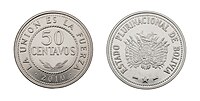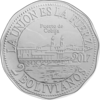Boliviano (currency)
The boliviano (symbol: Bs, ISO 4217 code: BOB) is the legal tender of the Plurinational State of Bolivia since 1987. It is divided into 100 cents and entered national circulation, replacing the old Bolivian peso. The Central Bank of Bolivia (founded in 1928) is the economic body responsible for issuing the currency.
History
The Boliviano was introduced in 1864 and was in force until 1963, when it was replaced by the Bolivian peso.
Later, after a process of hyperinflation of the Bolivian peso, on November 28, 1986, President Víctor Paz Estenssoro signed the law to put into circulation, on January 1, 1987, a new fully convertible national currency, the Bolivian, equivalent to one million pesos and with a flexible exchange rate in relation to the dollar and which, after a transition period, is the only legally accepted currency as of January 1, 1988.
At that time, 1 dollar was worth 1.8/1.9 million pesos and 1 boliviano was roughly equivalent to 1 US dollar.[citation needed]
As of April 2018, the manager of the Central Bank of Bolivia, Pablo Ramos, announced the introduction of the new family of banknotes of the Plurinational State of Bolivia; it began with the 10 Bs bill, and then gradually introduced the 200 Bs bill, presented in April 2019. Latin America", was highlighted for its security measures, its aesthetics and its inclusion of prominent figures in Bolivian history, being among those who awarded the "High Security Printing Latin American Conference" (High Security Printing).
Coins
- In 1988, stainless steel coins of 2, 5 (in 1989 only), 10, 20 and 50 cents and 1 Bolivian (in 1987) were introduced, followed by 2 Bolivian stainless steel coins in 1991.
- The 10 cents of copper-plated steel and bleached smooth edge were introduced in 1997.
- The bimetallic coins of 5 Bolivians in 2001, until then the coins of 2 and 5 cents are no longer in circulation.
- The currency of 2 Bolivians has been coined in two sizes, both are in legal course. The smallest Bolivian currency is almost the same as the currency of 1 Bolivian, giving rise to the possible confusion, although the 2 Bolivian coins have a polyedral border of 11 sides, while the 1 Bolivian coins are of round and smooth edge.
- All currencies in Bolivia have on the reverse the number of the amount of money with the inscription "The union is the Force"; on the reverse the Bolivian shield with the inscription "Republic of Bolivia" (emitted until 2009), and those issued from 2010 only changes the inscription to "Plurinational State of Bolivia".
Coins alluding to the Maritime Claim
In March 2017, the Central Bank of Bolivia put commemorative coins into circulation, alluding to the maritime claim. The coins are Bs2 and have the figures of the Bolivian Colorados Battalion and Genoveva Ríos. They are legal tender with that value. Later, in November 2017, other coins with the same concept were put into circulation, this time with figures of Eduardo Abaroa and the Port of Cobija. A total of 16,800,000 coins were put into circulation.
Tickets
- In 1987, Bolivian bills were overprinted with denominations in pennies and Bolivians to produce provisional emissions of 1, 5, 10 and 50 cents, and 1, 5 and 10 Bolivians.
- Regular emissions followed the same year in denominations of 2, 5, 10, 20, 50, 100 and 200 Bolivians.
- The ticket of 2 Bolivians was replaced by a stainless steel coin of 6.25gr in 1991, the same end suffered that of 5 Bolivians that was replaced by the bimetallic currency of five Bolivians in 2001, although the Central Bank of Bolivia still showed the ticket of 5 Bolivians as "in circulation"
- Since 2013, tickets of 2 and 5 Bolivians were officially out of circulation.
First series
| Denomination | Main color | Reverse | Reversal |
|---|---|---|---|
| 2 Bolivians | Black tones | The doctor and writer Antonio Vaca Diez | An image of the city of Cobija, capital of the department of Pando. |
| 5 Bolivians | Green tones | The writer Adela Zamudio | An image of the Virgin of the Socavón of the city of Oruro. |
| Denomination | Main color | Reverse | Reversal |
|---|---|---|---|
| 10 Bolivians | Blue tones | The painter Cecilio Guzmán de Rojas | An image of the Coronilla Heroins next to the city of Cochabamba. |
| 20 Bolivians | Orange tones | Counsel Pantaleón Dalence | An image of the Golden House of the City of Tarija. |
| 50 Bolivians | violet tones | The painter Melchor Pérez de Holguín | An image of the Tower of the Church of the Society of Jesus in the city of Potosí. |
| 100 Bolivians | Red tones | The historian Gabriel Moreno | An image of the Universidad Mayor Real y Pontificia de San Francisco Xavier de Chuquisaca in the capital, the city of Sucre. |
| 200 Bolivians | Brown tones | The writer and politician Franz Tamayo | An image of the pre-incaic ruins of the Tihuanacota Empire on the shores of the Titicaca Lake in the department of La Paz. |
Second series "Plurinational State of Bolivia"
The Central Bank of Bolivia announced a new family of banknotes that began to circulate in April 2018. They currently coexist with the previous banknotes. The new banknotes present characters and images with national representatives on the obverse and places of interest on the reverse. Although an exact decree for the design of these bills is not known, it is considered that they contribute significantly to the Bolivian representation.
| Denomination | Main color | Reverse | Reversal | Entry into circulation |
|---|---|---|---|---|
| 10 Bolivians | Blue tones | José 'el Tambor' Vargas, Apiaguaiki Tüpa, Eustaquio El 'Moto' Méndez y Cavernas de Umajalanta en el Parque nacional Toro Toro | The Island of Fish in the Salar of Uyuni, Puya Raimondi and Picaflor Giant | 10 April 2018 |
| 20 Bolivians | Orange tones | Genoveva Ríos, Tomás Katari, Pedro Ignacio Muiba and the Fort of Samaipata | the Bay Lagoon, the Black Cayman and the Toborochi Tree | 3 July 2018 |
| 50 Bolivians | Violet tones | José Manuel Baca “Cañoto”, Bruno Racua, Pablo Zárate Willca and the Fortress of Incallajta | The Nevado Sajama, flamenco and the real Quinua, | 15 October 2018 |
| 100 Bolivians | Red tones | Juana Azurduy de Padilla, Alejo Calatayud, Mariscal Antonio José de Sucre and the Potosí Coin House | Arco Iris Falls located in Santa Cruz, the Blue Paraba and the Patuju Flower. | January 15, 2019 |
| 200 Bolivians | Coffee tones | Tupac Katari, Bartolina Sisa, the Liberator Simon Bolivar and the House of Freedom of Sucre | Tiwanaku, located in La Paz, the Andean Cat and the Kantuta flower. | 23 April 2019 |
Fixed exchange rate
In a fixed exchange rate system, the Central Bank of Bolivia agrees to buy and sell foreign currency at a previously set price of Bs 6.86 for purchase and Bs 6.96 for sale for 1 $US respectively from November 2011 to the present, which are more than eleven continuous years. The consequences of this system are crucial, although in practice they are not understood in their real dimension of their effects in the short and long term on the country's economy.[citation required]
Manufacturing
Although Bolivia was one of the main mints of the colonial era (Casa de la Moneda, Potosí) the minting and printing of coins stopped due to a lack of political interest and the idea that coins and bank notes made abroad could be acquired at a lower price than doing it in the country.
As of 2013, the boliviano is still manufactured abroad, in countries such as the United Kingdom, France, and Chile.[citation needed]
Nomenclature
The writing of expressions that indicate a quantity of bolivianos is done by means of the symbol Bs followed by the numerical expression. Between the symbol Bs and the number there must be no space or any symbol. Example: Bs733 to express 733 bolivianos.
Do not confuse the symbol Bs with that of the Venezuelan bolivar (Bs.) even though they are very similar to each other.
Contenido relacionado
Comercial establishment
Partial equilibrium
Italian lira
Ecuadorian sucre
Offer and demand












